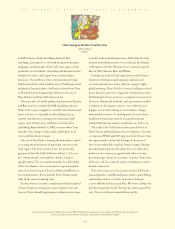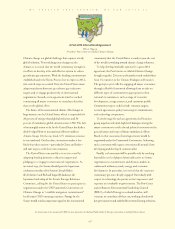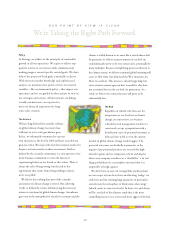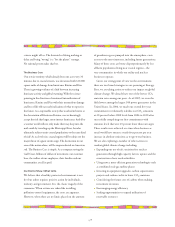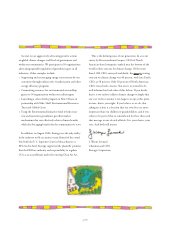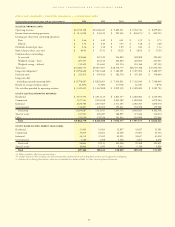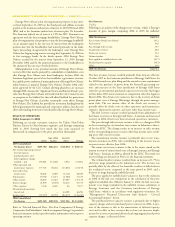Entergy 2006 Annual Report Download - page 35
Download and view the complete annual report
Please find page 35 of the 2006 Entergy annual report below. You can navigate through the pages in the report by either clicking on the pages listed below, or by using the keyword search tool below to find specific information within the annual report.
cp9
science might tell us. The downside of doing nothing or
delay and being “wrong” is a “bet the planet” strategy.
No rational person takes that bet.
The Business Case
Our service territory, which already loses one acre every 34
minutes due to coastal erosion, was devastated with 120,000
square miles of damage from hurricanes Katrina and Rita.
There is growing evidence of a link between increasing
hurricane activity and global warming. With the science
pointing in the direction of continued intensification of
hurricanes, Katrina and Rita with their tremendous damage
and loss of life offer an early indication of what to expect in
the future. As a responsible society that watched in horror at
the devastation of Hurricane Katrina, can we knowingly
accept the risk that larger, more intense hurricanes, fueled by
a warmer world will not only make their way deep into the
mid-south by traveling up the Mississippi River, but also
ultimately subject entire coastal populations to the same kind
of risk? As sea levels rise, coastal regions will be subject to the
major threat of a giant storm surge. The destruction in our
area of the nation alone, will be unprecedented on American
soil. The Business Case is simple. As a company serving the
Gulf Coast, billions of dollars of investment, our customer
base, the welfare of our employees, their families and our
communities are all in peril.
Our Point of View / What to Do
We believe that a healthy, protected environment is not
free but rather requires positive action by individuals,
industry and government. It is the classic tragedy of the
commons. When actions are taken like installing
pollution-control equipment, the costs are apparent.
However, when there are no limits placed on the amount
of greenhouse gases pumped into the atmosphere, costs
accrue to the most innocent, including future generations.
Many of those costs are borne disproportionately by less
affluent populations living near coastal regions – the
very communities in which our utility and nuclear
businesses operate.
Given our strong point of view on the environment,
there are two broad strategies we are pursuing at Entergy.
First, we are taking action to reduce our impact on global
climate change. We already have one of the lowest CO2
emission rates among our peers. As of 2005, we were the
fifth lowest among the largest 100 power generators in the
United States. In 2006, we made our second five-year
commitment to voluntarily stabilize our CO2emissions
at 20 percent below 2000 levels from 2006 to 2010 after
successfully completing our first commitment with
emission levels that were 23 percent lower than our target.
These results were achieved at a time when business as
usual would have meant a steady four percent per year
increase in absolute emissions as we grew our business.
We are also exploring a number of other actions to
combat global climate change including:
■Expanding our use of safe, emission-free nuclear
generation through high capacity factors, uprates and the
construction of new nuclear facilities
■Using newer, more efficient generation technologies such
as combined-cycle gas turbine plants
■Investing in equipment upgrades, carbon sequestration
projects and carbon credits to lower CO2emissions
■Considering the future cost of carbon when making
investment decisions
■Encouraging energy efficiency
■Seeking opportunities to expand utilization of
renewable resources







